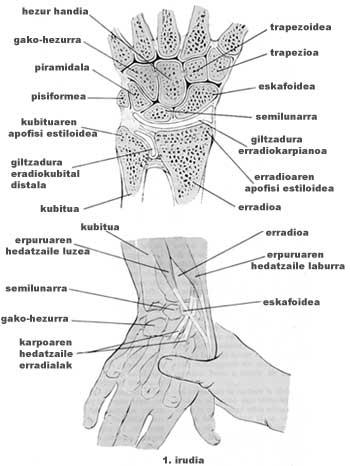Carpal tunnel syndrome
In this sense, especially in the last century and due to industrialization, the changes that have occurred in the environment have been so important that the pathological processes that human beings suffer today have changed drastically, both in terms of the nature of the pathology and in terms of the frequency and intensity of them.

Through an example we better understand what was said. It is clear that infections have decreased as psychosomatic diseases rise, or that some professional diseases have disappeared and new ones appear. If you look at these new work-related diseases, there are others that are increasing day by day in all administrative tasks, some caused by environmental factors (such as air conditioning), posturals (as a result of the passage of many hours sitting) or microtrauma that are affecting silently but continues a body load, in some cases producing a significant alteration. Carpal tunnel syndrome is a disease of the latter group.
But before we talk about this disease, we will take our hand (as the symptoms appear there) and analyze it as an almost perfect precision machine, that is, as a machine that works precisely to the intensity of the force that can exert in any action to control the movements. For any movement, the hand uses agonistic and antagonistic muscles, for example, while some muscles allow to close the fist, others open the hand; some muscles make the hand suppress (the palm is face up) and others cause it to pronation (the palm is put down).
Most of the muscles that move the hand are like pulleys and levers; meat or muscle, that is, striated muscle fiber generates strength and tendons transmit this energy to the point of joining the bones to produce movement. Precision movements, actions that require delicacy, occur in the muscles of the hand and fingers, while force movements occur in the folding muscles and finger extenders that have the original inserts in the forearm.
Like any machine, this locomotion or movement system requires a maintenance service, in this case, the synovial fluid of the joints properly lubricates the machine and the waste is eliminated by the blood stream and metabolism. But above all this, there is a peripheral nervous system, on the one hand to receive orders (i.e. sensations) and on the other to perform appropriate motor actions (movements). If the functions of the nerve are altered the whole system is damaged and from there anesthesia, paralysis and atrophy can be derived.

Come back by hand. The carp is an area between the phalanx or fingers and the wrist, formed by eight bones: scaphoid, seedling, pyramidal, pisiform, trapezoid, large bone and key bone, as well as a flexible arch capable of maintaining the tension due to the tendons of the muscles and properly channel these loads (see figure 1). In the front (concave) part of the carp a kind of passage or tunnel is formed, with the bones under and on the sides and the transverse ligament of the carp on the top of a totally resistant roof. Through this narrow and rigid passage pass nine folding tendons, the median nerve and the synovial capsule (cartilage drawer that protects the tendons and carries synovial fluid).
When in this tunnel or walkway the median nerve is crushed, a series of symptoms and signs appear. This morbid situation is called carpal tunnel syndrome. The main symptoms of this syndrome are paresthesia, disturbances of feeling: a sensation of tingling that is apparently unjustified, extending from the thumb to the middle of the sharp finger or a kind of twisting in the same area, which are stronger and more frequent among women and the most active hand. These sensations can extend to both the forearm and arm, to the point of shaking or forcing it to awaken the arm.
In some cases, skin disorders may appear along with paresthesia, but motor deficits, often painful, are more frequent, certain movements of the fingers, especially the pincer movements with the thumb and index finger, until their loss.
All symptoms get worse with the shoulder and percussion of the wrist, as well as if the wrist expands to 90º toward the back, which is called hyperextension. Special laboratory tests, such as electromyography, clearly show that the conduction of the median nerve is very slow.
The process progresses slowly and therefore, at first the person does not pay too much attention to the tingling or pain until the hand is unused by the action of the pain. It may be a short season, but it can also last for years or a lifetime, as has happened with some violins or pianists.
And can anyone think of this syndrome as important as deserving an article? Why is so much attention paid to him? Because what was once a matter of few people (famous musicians on the one hand, housewives and certain cleaners on the other) today, since the use of the computer has been imposed, much has spread among the people who work in the office.

How to prevent carpal tunnel syndrome? First of all, it is necessary to have a proper posture, sitting in a chair that allows us to form a 90º angle between the trunk and the thighs, if it is possible to keep the arms supported and parallel to the floor and the keyboard. Special attention must be paid to the inadequate postures that the arms and hands may adopt during typing and/or writing hours.
It is advisable to stop work for a few minutes and relax your hands, if possible keep them warm and comfortable, without watches or bracelets that tighten the wrists. Within the secondary measures, discard saline excesses, which involve water retention, not smoking, which can lower up to 60% of blood circulation, perform exercises to strengthen the circulation and lymphatic system and, although occasionally, take into account the convenience of performing body stretches. On the other hand, a healthy, balanced and harmonious diet keeps water metabolism stable, which causes synovial fluid to be tailored to the synovial capsule of the joints, while decreasing body fat.
Finally, if medical treatment is required, analgesics and anti-inflammatories are used, in some cases along with temporary work loss. Massages, acupuncture, and electropuncture may also be alternatives to prevent this increasingly common disease.





